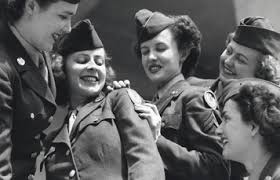HOW ROSIE INSPIRED WOMEN TO SERVE
The “Rosie the Riveter” movement was the catapult that set women in the workforce, and in doing so, changed the make-up of the American workforce. Previous to the war, men historically worked and women stayed home to care for the family. The U.S. needed help to replace male workers who left their jobs to fight for our country. A campaign was launched to motivate American women to join the workforce and help with the war effort. This campaign not only helped the war effort, but changed the way women saw their role in society. One of the workforces that became well known in support of the war was the Women Ordnance Workers (WOWs).

Women Ordnance Workers were established in 1942 to assist in the production of military hardware. These women, as depicted by Rosie the Riveter, wore hardhats, coveralls, and delivered the same workload as their male predecessors. Not only did they operate cranes and milling machines, they also bagged gunpowder, made weapons, crated ammunition and did whatever was needed to assist our war effort.
Many of them wore a red bandana with a small white flaming bomb graphic displayed all over the bandana. The bandana was not only created for safety reasons but to encourage patriotism and a sense of accomplishment among these workers. The WOW bandanna became a well-known symbol of the 85,000 women who worked directly for the Ordnance Department.
In an advertisement of the July-August 1943 issue of Army Ordnance, the bandana was highlighted as follows:
“… and she wears the WOW bandanna. Water Repellent. Washable. Dust Proof. The “WOW” Bandanna, designed in accordance with U.S. Army specification, is an attractive, safe, and unifying head covering to identify Women Ordnance Workers. About 27″ square, it is available either in Ordnance red with white Ordnance insignia, or in white with red Ordnance insignia. Every woman in your plant will want one–it’s a “WOW” for morale! $3.75 per dozen, net F.O.B., New York. Manufactured under authorization from the Army Ordnance Department. We invite your inquiry. BRIAN FABRICS CORPORATION, 1441 BROADWAY, NEW YORK CITY.”
Another off-shoot of the “Rosie the Riveter” movement was the establishment of the Women’s Auxiliary Army Corps (WAAC). Several hundred thousand women volunteered to “free a man to fight.” They were issued uniforms, and replaced soldiers in clerical and other non-combat related jobs. The WAACs had no official military status until 1943. When the WAACs officially became part of the Armed Forces, their name was changed to the Women’s Army Corps (WAC). The WACs not only served as clerks, they also drove trucks, tested weapons, and ferried bombers and other aircraft across country and overseas. The more mechanically inclined repaired and maintained tanks and others tracked and wheeled vehicles.
While it cannot be said that the jobs held by the WOWs and WACs were as dangerous as those of the combat soldiers, the simple fact is, that many of their jobs were more dangerous than the ones held by many of the men overseas. While many of the men were behind the lines serving the war effort as clerks, cooks, bakers, supply and maintenance personnel and staff officers of all types, many of the women were working in shifts around the clock bagging gunpowder and manufacturing artillery shells, and other high explosives. They suffered the effects of spray painting, welding, hanging from single suspension scaffolds and shooting hot rivets into the hulls of ships under construction, working with all kinds of dangerous chemicals, and many other equally hazardous jobs. While the risk of being killed or wounded by the enemy were nil, the risks of injury and death they faced were often equal to those faced by the men overseas.

Become a supporter today of the U.S. Army Museum of Hawaii, by purchasing a souvenir Ha-Go Shirt. All donations support the maintenance and upkeep of the our artifacts and exhibits.
We look forward to seeing you soon!
